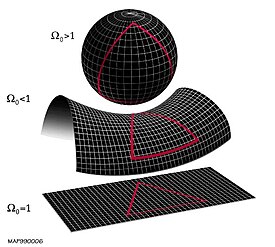Going back to CMB cosmic microwave background radiation, using this allows us to actually calculate what the curvature of the universe is. The geometry of the universe is related to its density which is originally used to determine the fate of the universe, whether or not it will collapse or expand forever. The term "critical density" is used as the turning point of whether or not the universe collapses or expands, although this is without the use of Dark Energy, which when added can affect whether or not it goes one way or the other. Of course the other use as stated above is the curvature of the universe, whether the universe is flat, open, or closed, as the picture above shows from NASA's article.
If the density of the universe is greater then the critical density, then the universe is closed, and shaped like that on the top, of a sphere where light can circle around the universe and get back to the starting point again if the universe lasts long enough. If the density of the universe is less then the critical density, then the universe is open, and shaped like the one in the middle, going on forever and negatively curved. However findings show that the universe is equal to the critical density, causing it to be flat like the bottom picture, and thus expanding infinitely.
This measurement is taken with WMAP a spacecraft that can measure CMB and they look for fluctuations or "spots" in the CMB. When they find these spots, they can measure the distance between two of them, and based upon the distance with the parameters of the big bang theory, they can calculate what the shape of the universe is. If these spots were to be more than one degree apart then the universe is closed, less then one degree and the universe is open. Now if the spots are about one degree across then the universe is flat, and this is what they were able to calculate to within a 0.5% error. This conclusion gives us what the density of the universe is as well which is equal to it's "critical density" which helps with calculations such as the expansion rate of the universe and how much dark matter is in the universe all used together in the Lambda-Cold Dark Matter model of the universe.

No comments:
Post a Comment